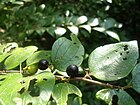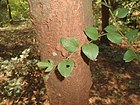Note: This is a project under development. The articles on this wiki are just being initiated and broadly incomplete. You can Help creating new pages.
Difference between revisions of "Ziziphus xylopyra"
(Created page with "{{stub}} ==Uses== {{Uses|}}, {{Uses|}}, {{Uses|}}, {{Uses|}}, {{Uses|}}, {{Uses|}}, {{Uses|}}, {{Uses|}}, {{Uses|}}, {{Uses|}}, {{Uses|}}.<ref name="Uses"/> ==Parts Used== {{...") |
|||
| (2 intermediate revisions by the same user not shown) | |||
| Line 1: | Line 1: | ||
| − | + | [[File:Ziziphus xylopyrus AJTJ DSCN0180.jpg|thumb|right]] | |
| + | '''Ziziphus abyssinica''' is a fiercely thorny, semideciduous plant, varying in habit from an erect shrub; a scrambling plant that clambers into other vegetation for support; or a tree with drooping branches that form a heavy, rounded crown. It usually grows from 3 - 12 metres tall. | ||
==Uses== | ==Uses== | ||
| − | {{Uses|}}, {{Uses|}}, {{Uses|}} | + | {{Uses|Stomachache}}, {{Uses|Snakebite}}, {{Uses|Pneumonia}}.<ref name="Uses"/> |
| + | |||
| + | ===Food=== | ||
| + | Ziziphus xylopyra can be used in Food. Seed kernels are consumed after drying.<ref name="Forest foods of Western Ghat"/> | ||
==Parts Used== | ==Parts Used== | ||
| − | {{Parts Used|}}, {{Parts Used| | + | {{Parts Used|Fruits}}, {{Parts Used|Leaves}}. |
==Chemical Composition== | ==Chemical Composition== | ||
| − | <ref name="chemical composition"/> | + | The major chemical composition of Z. xylopyrus are rich in flavonoids in particular quercetin, quercitrin, kaempferol-4’-methylether and kaempferol, tannins (7.2%), d-7, 3’, 4’-trihydroxyflavan-3, 4-diol and oleanolic acid etc.<ref name="chemical composition"/> |
==Common names== | ==Common names== | ||
| − | {{Common names|sa=|en=|gu=|hi=|kn=|ks=|ml=|mr=|pa=|ta=|te=}} | + | {{Common names|sa=|en=Kath Ber|gu=|hi=Kathber|kn=ಗೊಟ್ಟೆ Gotte|ks=|ml=|mr=Ghatbor|pa=|ta=Mulkottai|te=Gotti Chettu}}<ref name="Common names"/> |
==Properties== | ==Properties== | ||
| Line 16: | Line 20: | ||
===Dravya=== | ===Dravya=== | ||
===Rasa=== | ===Rasa=== | ||
| − | |||
===Guna=== | ===Guna=== | ||
| Line 27: | Line 30: | ||
===Prabhava=== | ===Prabhava=== | ||
| + | |||
| + | ===Nutritional components=== | ||
| + | Ziziphus xylopyra Contains the Following nutritional components like - Vitamin-A,B and C; Betulinic acid, Carotene, Citric acid; Flavonoides; Lupeol; Quercetin; Tannins; Calcium, Copper, Iron, Magnesium, Manganese, Phosphorus, Potassium, Sulphur, Zinc<ref name="Forest foods of Western Ghat"/> | ||
==Habit== | ==Habit== | ||
| − | {{Habit|}} | + | {{Habit|Semi-deciduous shrub}} |
==Identification== | ==Identification== | ||
| Line 48: | Line 54: | ||
==Mode of Propagation== | ==Mode of Propagation== | ||
| − | {{Propagation|}} | + | {{Propagation|Seeds}} |
==How to plant/cultivate== | ==How to plant/cultivate== | ||
| − | <ref name="How to plant/cultivate"/> | + | A plant usually of the drier areas of the hot tropics, where it can be found at elevations from 400 - 2,000 metres<ref name="How to plant/cultivate"/>. Ziziphus xylopyra is available from April to July<ref name="Forest foods of Western Ghat"/>. |
==Commonly seen growing in areas== | ==Commonly seen growing in areas== | ||
| − | {{Commonly seen|}}, {{Commonly seen|}}, {{Commonly seen| | + | {{Commonly seen|Scattered tree grassland}}, {{Commonly seen|Combretum-Terminalia woodlands}}, {{Commonly seen|Acacia woodlands}}. |
==Photo Gallery== | ==Photo Gallery== | ||
<gallery class="left" caption="" widths="140px" heights="140px"> | <gallery class="left" caption="" widths="140px" heights="140px"> | ||
| − | + | (Ziziphus xylopyrus) at Kambalakonda Wildlife Sanctuary.jpg | |
| + | (Ziziphus xylopyrus) tree bark at Kambalakonda.jpg | ||
| + | Ghator (Hindi- घटोर) (9971660253).jpg | ||
| + | Raw woody-fruited jujube fruit (Ziziphus xylopyrus) at Kambalakonda Wildlife Sanctuary.jpg | ||
| + | Ziziphus xylopyrus - fruits.JPG | ||
| + | Ziziphus xylopyrus AJTJ DSCN0180.jpg | ||
</gallery> | </gallery> | ||
| Line 64: | Line 75: | ||
<references> | <references> | ||
| − | <ref name="chemical composition">[ | + | <ref name="chemical composition">[https://www.farmavita.net/farmavitanet-journal/life-science-files/53-life-science-article/1626-zizyphus-xylopyrus#:~:text=The%20major%20chemical%20composition%20of,4%2Ddiol%20and%20oleanolic%20acid. Chemical constituents]</ref> |
| − | + | <ref name="Leaf">[Morphology]</ref> | |
| − | <ref name="Leaf">[" | + | <ref name="Common names">[http://www.flowersofindia.net/catalog/slides/Kath%20Ber.html#:~:text=Ziziphus%20xylopyrus%20%2D%20Kath%20Ber&text=Kath%20Ber%20is%20a%20large,blunt%2C%20base%20oblique%2C%20rounded. Common names]</ref> |
| − | + | <ref name="How to plant/cultivate">[http://tropical.theferns.info/viewtropical.php?id=Ziziphus+abyssinica Cultivation]</ref> | |
| − | <ref name="How to plant/cultivate">[ | ||
<ref name="Uses">Indian Medicinal Plants by C.P.Khare</ref> | <ref name="Uses">Indian Medicinal Plants by C.P.Khare</ref> | ||
| + | <ref name="Forest foods of Western Ghat">"Forest food for Northern region of Western Ghats" by Dr. Mandar N. Datar and Dr. Anuradha S. Upadhye, Page No.156, Published by Maharashtra Association for the Cultivation of Science (MACS) Agharkar Research Institute, Gopal Ganesh Agarkar Road, Pune</ref> | ||
</references> | </references> | ||
==External Links== | ==External Links== | ||
| − | * [ ] | + | * [https://indiabiodiversity.org/species/show/31935 Ziziphus xylopyra on indiabiodiversity.org] |
| − | * [ ] | + | * [https://pdfs.semanticscholar.org/4440/841b2cd4ac8e077d75c2369aec8538910929.pdf Ziziphus xylopyra on semanticscholar.org] |
| − | + | ||
[[Category:Herbs]] | [[Category:Herbs]] | ||
Latest revision as of 12:56, 29 November 2021
Ziziphus abyssinica is a fiercely thorny, semideciduous plant, varying in habit from an erect shrub; a scrambling plant that clambers into other vegetation for support; or a tree with drooping branches that form a heavy, rounded crown. It usually grows from 3 - 12 metres tall.
Contents
- 1 Uses
- 2 Parts Used
- 3 Chemical Composition
- 4 Common names
- 5 Properties
- 6 Habit
- 7 Identification
- 8 List of Ayurvedic medicine in which the herb is used
- 9 Where to get the saplings
- 10 Mode of Propagation
- 11 How to plant/cultivate
- 12 Commonly seen growing in areas
- 13 Photo Gallery
- 14 References
- 15 External Links
Uses
Stomachache, Snakebite, Pneumonia.[1]
Food
Ziziphus xylopyra can be used in Food. Seed kernels are consumed after drying.[2]
Parts Used
Chemical Composition
The major chemical composition of Z. xylopyrus are rich in flavonoids in particular quercetin, quercitrin, kaempferol-4’-methylether and kaempferol, tannins (7.2%), d-7, 3’, 4’-trihydroxyflavan-3, 4-diol and oleanolic acid etc.[3]
Common names
| Language | Common name |
|---|---|
| Kannada | ಗೊಟ್ಟೆ Gotte |
| Hindi | Kathber |
| Malayalam | |
| Tamil | Mulkottai |
| Telugu | Gotti Chettu |
| Marathi | Ghatbor |
| Gujarathi | |
| Punjabi | |
| Kashmiri | |
| Sanskrit | |
| English | Kath Ber |
Properties
Reference: Dravya - Substance, Rasa - Taste, Guna - Qualities, Veerya - Potency, Vipaka - Post-digesion effect, Karma - Pharmacological activity, Prabhava - Therepeutics.
Dravya
Rasa
Guna
Veerya
Vipaka
Karma
Prabhava
Nutritional components
Ziziphus xylopyra Contains the Following nutritional components like - Vitamin-A,B and C; Betulinic acid, Carotene, Citric acid; Flavonoides; Lupeol; Quercetin; Tannins; Calcium, Copper, Iron, Magnesium, Manganese, Phosphorus, Potassium, Sulphur, Zinc[2]
Habit
Identification
Leaf
| Kind | Shape | Feature |
|---|---|---|
Flower
| Type | Size | Color and composition | Stamen | More information |
|---|---|---|---|---|
| {{{5}}} |
Fruit
| Type | Size | Mass | Appearance | Seeds | More information |
|---|---|---|---|---|---|
Other features
List of Ayurvedic medicine in which the herb is used
Where to get the saplings
Mode of Propagation
How to plant/cultivate
A plant usually of the drier areas of the hot tropics, where it can be found at elevations from 400 - 2,000 metres[6]. Ziziphus xylopyra is available from April to July[2].
Commonly seen growing in areas
Scattered tree grassland, Combretum-Terminalia woodlands, Acacia woodlands.
Photo Gallery
References
- ↑ Indian Medicinal Plants by C.P.Khare
- ↑ 2.0 2.1 2.2 "Forest food for Northern region of Western Ghats" by Dr. Mandar N. Datar and Dr. Anuradha S. Upadhye, Page No.156, Published by Maharashtra Association for the Cultivation of Science (MACS) Agharkar Research Institute, Gopal Ganesh Agarkar Road, Pune
- ↑ Chemical constituents
- ↑ Common names
- ↑ [Morphology]
- ↑ Cultivation
External Links
- Ayurvedic Herbs known to be helpful to treat Stomachache
- Ayurvedic Herbs known to be helpful to treat Snakebite
- Ayurvedic Herbs known to be helpful to treat Pneumonia
- Herbs with Fruits used in medicine
- Herbs with Leaves used in medicine
- Herbs with common name in Kannada
- Herbs with common name in Hindi
- Herbs with common name in Tamil
- Herbs with common name in Telugu
- Herbs with common name in Marathi
- Herbs with common name in English
- Habit - Semi-deciduous shrub
- Index of Plants which can be propagated by Seeds
- Herbs that are commonly seen in the region of Scattered tree grassland
- Herbs that are commonly seen in the region of Combretum-Terminalia woodlands
- Herbs that are commonly seen in the region of Acacia woodlands
- Herbs






